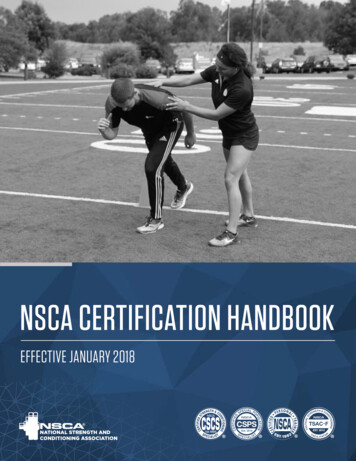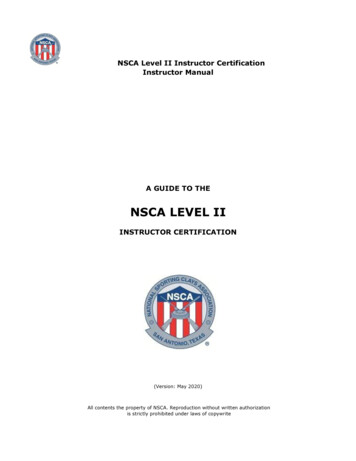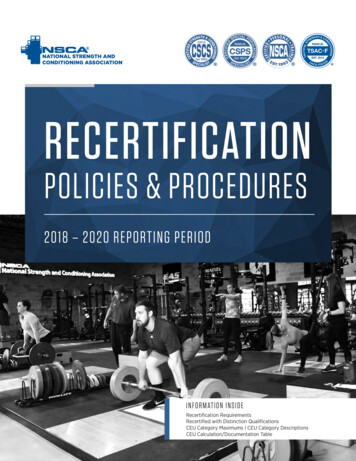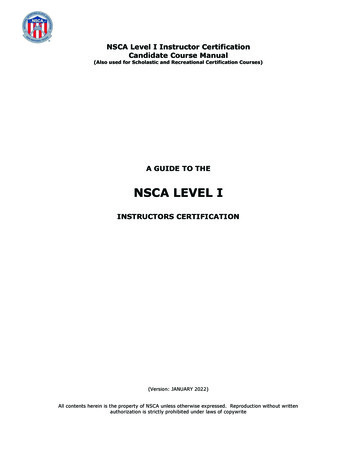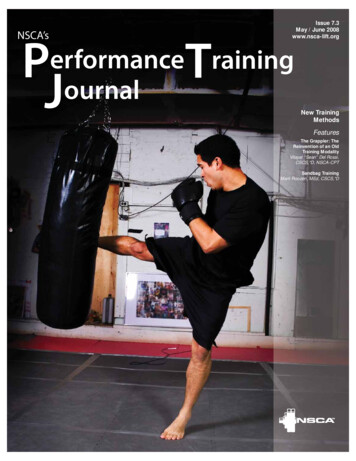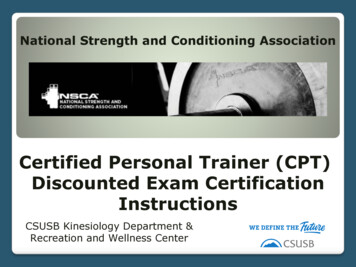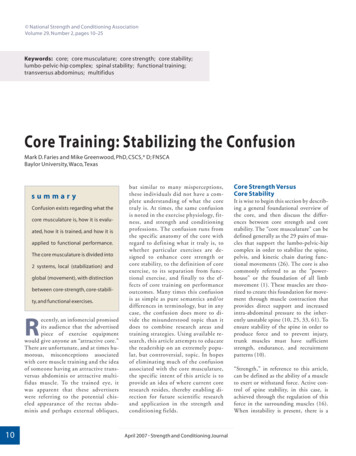
Transcription
National Strength and Conditioning AssociationVolume 29, Number 2, pages 10–25Keywords: core; core musculature; core strength; core stability;lumbo-pelvic-hip complex; spinal stability; functional training;transversus abdominus; multifidusCore Training: Stabilizing the ConfusionMark D. Faries and Mike Greenwood, PhD, CSCS,* D; FNSCABaylor University, Waco,TexassummaryConfusion exists regarding what thecore musculature is, how it is evaluated, how it is trained, and how it isapplied to functional performance.The core musculature is divided into2 systems, local (stabilization) andglobal (movement), with distinctionbetween core-strength, core-stability, and functional exercises.ecently, an infomercial promisedits audience that the advertisedpiece of exercise equipmentwould give anyone an “attractive core.”There are unfortunate, and at times humorous, misconceptions associatedwith core muscle training and the ideaof someone having an attractive transversus abdominis or attractive multifidus muscle. To the trained eye, itwas apparent that these advertiserswere referring to the potential chiseled appearance of the rectus abdominis and perhaps external obliques,R10but similar to many misperceptions,these individuals did not have a complete understanding of what the coretruly is. At times, the same confusionis noted in the exercise physiology, fitness, and strength and conditioningprofessions. The confusion runs fromthe specific anatomy of the core withregard to defining what it truly is, towhether particular exercises are designed to enhance core strength orcore stability, to the definition of coreexercise, to its separation from functional exercise, and finally to the effects of core training on performanceoutcomes. Many times this confusionis as simple as pure semantics and/ordifferences in terminology, but in anycase, the confusion does more to divide the misunderstood topic than itdoes to combine research areas andtraining strategies. Using available research, this article attempts to educatethe readership on an extremely popular, but controversial, topic. In hopesof eliminating much of the confusionassociated with the core musculature,the specific intent of this article is toprovide an idea of where current coreresearch resides, thereby enabling direction for future scientific researchand application in the strength andconditioning fields.April 2007 Strength and Conditioning JournalCore Strength VersusCore StabilityIt is wise to begin this section by describing a general foundational overview ofthe core, and then discuss the differences between core strength and corestability. The “core musculature” can bedefined generally as the 29 pairs of muscles that support the lumbo-pelvic-hipcomplex in order to stabilize the spine,pelvis, and kinetic chain during functional movements (26). The core is alsocommonly referred to as the “powerhouse” or the foundation of all limbmovement (1). These muscles are theorized to create this foundation for movement through muscle contraction thatprovides direct support and increasedintra-abdominal pressure to the inherently unstable spine (10, 25, 33, 61). Toensure stability of the spine in order toproduce force and to prevent injury,trunk muscles must have sufficientstrength, endurance, and recruitmentpatterns (10).“Strength,” in reference to this article,can be defined as the ability of a muscleto exert or withstand force. Active control of spine stability, in this case, isachieved through the regulation of thisforce in the surrounding muscles (16).When instability is present, there is a
failure to maintain correct vertebralalignment, or, in other words, a failurein the musculature to apply enoughforce to stabilize the spine. So, “stability” describes the ability of the body tocontrol the whole range of motion of ajoint so there is no major deformity,neurological deficit, or incapacitatingpain (51, 53). In general, the goal of thecore musculature is to stabilize the spineduring functional demands, because thebody wants to maximize this stability (1,16). This level of stability and kinematicresponse of the trunk is determined bythe mechanical stability level of thespine and the reflex response of thetrunk muscles prior to force being applied to the body (16). Limb movementprovides exertional force onto the spine,where the magnitude of reactive forces isproportional to the inertia of the limb(35, 37), whereas coactivation of the agonistic and antagonistic trunk muscleswork to stiffen the lumbar spine to increase its stability (16). There is a concern, which is discussed later, that toomuch strength or force from core musculature actually can cause greater instability if it is not directed correctly. Also,there is evidence to support that endurance is the more important trainingvariable when it comes to the core musculature (46, 47).With a general understanding of the goalof the core musculature to stabilize thespine against forces, one can begin to separate the confusion between the terms“core stability” and “core strength,” despite the limited research. When theterm “core stability” is used, reference isbeing made to the stability of the spine,not the stability of the muscles themselves. Within the research, there hasbeen no reference to enhancing the stability of a muscle, but rather its ability tocontract. When the term “core strength”is used, reference is being made to theability of the musculature to stabilizethe spine through contractile forces andintra-abdominal pressure. Cholewickiand colleagues confirm that “active control of spine stability is achievedTable 1Muscle CharacteristicsLocalGlobalDeeply placedSuperficialAponeuroticFusiformSlow-twitch natureFast-twitch natureActive in endurance activitiesActive in power activitiesSelectively weakenPreferential recruitmentPoor recruitment, may be inhibitedShorten and tightenActivated at low resistance levels(30–40% maximal voluntarycontraction)Activated at higher resistance levels(above 40% maximal voluntarycontraction)Lengthenthrough the regulation of force in thesurrounding muscles. Therefore, coactivation of agonistic and antagonistictrunk muscles stiffens the lumbar spineand increases its stability” (16,p. 1380). Increases in muscle activationpotentially lead to greater spinal stability. In the same vein, confusion also mayarise as to whether a given exercise is acore-strength or a core-stability exercise.Core exercises do not aim to increase thestability of the musculature, but ratheraim to enhance the muscles’ ability tostabilize the spine, particularly the lumbar spine. The confusion between corestrength and core stability may be clarified further with a proper understandingof the anatomy of the core musculature.Anatomy of the CoreMusculature: Local andGlobal SystemsLeonardo da Vinci first described theconcept of muscle grouping around thespine. He suggested that the centralmuscles of the neck stabilized the spinalsegments, whereas the more lateral muscles acted as guide ropes supporting thevertebrae (18). Bergmark first classifiedthe muscles acting on the lumbosacralspine as either “local” or “global” (9).Scientific modifications have been madeto these initial classifications (1, 51).The local and global muscles can be categorized according to the varying characteristics between them (Table 1). TheApril 2007 Strength and Conditioning Journallocal musculature (Table 2) includes thetransversus abdominis (TrA), multifidus, internal oblique, medial fibers ofexternal oblique, the quadratus lumborum, diaphragm, and pelvic floor muscles (61, 64). These muscles have shortermuscle lengths, attach directly to thevertebrae, and are primarily responsibleto generate sufficient force for segmental stability of the spine (10, 26, 61). Recent research has promoted the TrA andmultifidi as the primary stabilizers of thespine (26, 50, 51). The TrA is the deepest of the abdominal muscles, originating at the iliac crest, inguinal ligament,and thoracic and lumbar spinousprocesses via the thoracolumbar fascia,then attaching anteriorly at the lineaalba (49, 61). When contracted, it isable to increase tension of the thoracolumbar fascia and increase intra-abdominal pressure, which increases spinalstiffness in order to resist forces actingon the lumbar spine (26, 52, 61). Themultifidi attach from the vertebral arches to the spinous processes spanningfrom sacral to cervical spine. Each muscle spans 1–3 vertebral levels, thus providing the largest contribution to intersegmental stability (61). Because oftheir short moment arms, the multifidiare not involved with gross movement(1). The TrA and multifidi have beenfound to activate prior to limb movement in an attempt to stabilize the spinefor that movement (33–38). The TrA11
Table 2Core MusculatureLocal muscles(stabilization system)PrimaryGlobal muscles(movement system)SecondaryTransversus abdominisInternal obliqueRectus abdominisMultifidiMedial fibers of externalobliqueLateral fibers of externalobliqueQuadratus lumborumPsoas majorDiaphragmErector spinaePelvic floor musclesIliocostalis (thoracicportion)Iliocostalis andlognissimus(lumbar portions)has been shown to activate up to 100milliseconds before the activation oflimb musculature during limb reactiontime tests (30). The TrA, specifically, isactivated regardless of direction of limbmovement (26, 33–36, 38). This activation promotes spinal stability no matterthe direction and begins to confirm theprimary stabilizing function of the TrA.Due to the lone stabilization functions ofthe TrA and multifidi, the local systemcan be divided into primary and secondary stabilizers (Table 2). The primarystabilizers are the TrA and multifidi, because they do not create movement of thespine. The internal oblique, the medialfibers of the external oblique, and thequadratus lumborum function primarilyto stabilize the spine, but also functionsecondarily to move the spine (51).The muscles primarily in charge of producing movement and torque of thespine are the global muscles (Table 2).Global muscles (sometimes categorizedas “slings”) possess long levers and largemoment arms, making them capable ofproducing high outputs of torque, withemphasis on speed, power, and largerarcs of multiplanar movement, whilecountering external loads for transfer tothe local musculature (26, 61). Thesemuscles include the rectus abdominis,lateral fibers of the external oblique,12psoas major, and the erector spinae. Traditional exercises such as the sit-up havefocused on enhancing the capacity ofthis global musculature. It is thoughtthat exercises that produce gross movement of the spine, such as the sit-up,emphasize the global system and not thelocal system. These exercises emphasizethe global systems, not isolate the globalsystems, because both systems theoretically work in synergism (17). With reference to fiber typing, the local systemcomprises mainly type I fibers, whereasthe global system mainly consists of typeII fibers (57, 61). It should be notedhere that there are other, less researchedmuscles not labeled in the classificationof local and global musculatures, andthese classifications may vary with newand much needed discoveries from research investigations. With the lack ofcurrent research in this area and most investigations using populations withvariations of low back pain, it is difficultto make assumptions regarding the application of the core musculature to thestrength and conditioning populations.Nonetheless, these assumptions aremade.Application of the CoreMusculatureCore and lumbo-pelvic-hip stabilization research began by investigating individuals with low back pain, chronicApril 2007 Strength and Conditioning Journallow back pain, spondylolysis, and spondylolisthesis (22, 23, 34, 51, 52, 57,59, 64, 66). It has been shown that inindividuals with low back pain andlumbar instability, local stabilizingmuscles, including the TrA, are affectedpreferentially, resulting in inefficientmuscular stabilization of the spine(33–37, 52). Although in in vivoporcine studies, Hodges and colleagueshave shown the TrA to increase intraabdominal pressure, thus reducinglumbar intervertebral displacementand increasing lumbar stiffness (33).Despite the lack of in vivo TrA researchin humans, other research has been ableto create a strong theory of its importance, along with the other local muscles, in stabilizing the spine (1, 9, 16,22, 27, 33–38, 43). The core musculature becomes especially important asthe application of forces onto the spineduring events of life and sport challenges the musculature’s ability to stabilize and protect the spine.As previously stated, the spine is inherently unstable. The ligamentous spine(stripped of muscle) will fail or buckleunder compression loads of as little as 2kg or 20 N (10, 46). Level walking canproduce up to 140 N of compressionforce to each side of the spine with eachstep (20). Holding an 80-lb object infront of the body while standing in neutral posture will produce large compression forces of 2,000 N at the lower lumbar levels (24). Compression was foundto be 3,230 N for straight-leg sit-upsand 3,410 N for bent-knee sit-ups,whereas shear forces were 260 and 300N, respectively (47). Rowing has beenshown to produce peak spinal compression forces on the spine of 6,066 N formen and 5,031 N for women (3). Football blocking has been shown to produceaverage compression forces, anteroposterior shear forces, and lateral shearforces of 8,679 1,965 N; 3,304 116N; and 1,709 411 N, respectively (28).Half-squat exercises with barbell loadsin the range of 0.8–1.6 times bodyweight applied variant spinal compres-
sive loads between 6 and 10 times bodyweight (13). In other words, a 200-lbathlete lifting a barbell loaded to 320 lbsduring a half-squat would be applying2,000 lbs or almost 8,900 N of compressive force onto the lumbar spine.Cholewicki, McGill, and Normanshowed that the average compressiveloads on the L4-L5 joint of powerlifterswere estimated to be up to 17,192 N(15). Extreme lifting also has beenshown to produce loads on the lumbarspine of up to 36,400 N (29).These types of compressive loads at thelumbar spine, from life and sport, exceed those loads determined during fatigue studies to cause pathologicchanges in both the lumbar disk and thepars interarticularis, which contributeto conditions such as spondylolysis(28). Spine compression and lateralshear forces also have been shown to increase as the lift origin becomes moreasymmetric, with one-hand liftingchanging the compression and shearprofiles significantly (44). This knowledge is valuable, because much of lifeand sport requires not only extremeloading of the spinal musculature, butalso varying angles, positions, andspeeds. This understanding of the multiplanar forces that life and sport placeon the spine and the injury that couldensue have prompted individuals toseek methods to train the strength orstabilizing capacity, endurance, andneuromuscular reactive properties ofthe core musculature. It has been suggested that focus should move paststrength alone to understand the speedwith which the muscles contract in reaction to a force (51). It also has beensuggested that an individual whodemonstrates strong performance on astrength test of force may not necessarily display an equally strong performance on a test of endurance (43). Theindividual’s history and the specificityof training should dictate the outcomesof assessment tools and subsequenttraining emphasis. As with other muscular assessment, measures of the coreshould include various performancemeasures of force, endurance, andpower. This area, among many others, isone of needed future research.Assessing the Core MusculatureThere is limited research on the assessment of core musculature, which addsto some of the confusion associatedwith this topic. Clinically, core activation has been measured with ultrasound, magnetic resonance, and electromyography (3, 33–38, 50, 54, 64).One of the limitations in the clinical diagnosis of lumbar instability revolvesaround the difficulty to accurately detect abnormal or excessive intersegmental motion, with conventional radiologic testing often reported as beinginsensitive and unreliable (52). Therecould be possible advancements in theseareas, but current research with the coremusculature is lacking, to the authors’knowledge. Progress has been made toward simpler assessments of the coremusculature, with growing knowledgeof abdominal hollowing aiding thisprogress. Abdominal hollowing is specifically the cocontraction of the local system, especially the TrA, multifidi, internal oblique, diaphragm, and pelvicfloor musculature, while an individualisometrically contracts and draws in theabdominal wall or navel without movement of the spine or pelvis (5, 19, 22,52, 56, 57, 59, 60, 63). This drawing-inmaneuver is designed to emphasize thedeep local muscle activity, because thereis minimal activation of the more superficial global muscles, such as the rectusabdominis (51). It has been shown thatabdominal hollowing, rather than thesit-up movement, activates a cocontraction mechanism of the TrA, multifidus,and internal obliques, rather than therectus abdominis and external obliques,with increased activation of the TrAwhen lumbopelvic motion is limited(56, 59, 63). Abdominal hollowing alsohas been shown to increase the crosssectional area of the TrA (19). The research of abdominal hollowing providesimportant feedback as to the design ofApril 2007 Strength and Conditioning Journalfuture core assessment programs by illustrating that many exercises that maybe performed as core exercises do notpreferentially activate the local stabilization system of the core, but ratheremphasize the global musculature. Agrowing number of researchers, however, have concerns that abdominal hollowing during exercise can actuallycause injury and should not be advocated. The newer suggestion for athletesappears to be the abdominal bracingtechnique. This growing controversy isdiscussed in more detail in the next section.This focus on activating the stabilization system of the core is thought tocarry into future prescription for athletes as well. As it is, the most commonlyutilized assessments and training aredone in the supine or prone position.They are designed to assess or to trainthe stabilizing system with minimal activation of the movement system, but aquestion arises when athletes do not typically require spinal stabilization in asupine or prone position. Athletes andother individuals must be concernedwith spinal stability, including abdominal hollowing, with the effects such asgravity, external forces, and momentum.To the authors’ knowledge, there is nocurrent, valid test for the core musculature in a plane or position other thansupine and prone, along with limited research in quantifying the activation ofboth stability and global systems in theathlete. Assuming the law of specificityapplies to the core musculature as well,it may be beneficial for future researchto assess and to quantify the activationof the stabilization system in positionsmore specific to a given sport, function,or action.Posterior pelvic tilting also has been advocated to cause cocontraction of thelocal stabilization musculature. Nevertheless, it is not suggested at times dueto the increased activation of the rectusabdominis and speculation of negativepreload effects on the lumbar spine that13
Table 3Sahrmann Core Stability TestLevel 1Begin in supine, crook-lying position while abdominal hollowingSlowly raise 1 leg to 100 of hip flexion with comfortable knee flexionOpposite leg brought up to same position*Level 2From hip-flexed position, slowly lower 1 leg until heel contacts groundSlide out leg to fully extend the kneeReturn to starting flexed positionLevel 3From hip-flexed position, slowly lower 1 leg until heel is 12 cm abovegroundSlide out leg to fully extend the kneeReturn to starting flexed positionLevel 4From hip-flexed position, slowly lower both legs until heel contactsgroundSlide out legs to fully extend the kneesReturn to starting flexed positionLevel 5From hip-flexed position, slowly lower both legs until heels 12 cm abovegroundSlide out legs to fully extend the kneesReturn to starting flexed position* Subsequent levels begin in this hip-flexed position.often cause low back pain (22). For thepelvic tilt to be performed, the individual contracts the lower abdominal muscles to rotate the pelvis posteriorly, sothat the lumbar spine flattens out. Acommon posture is hyperlordotic,which tilts the pelvis anteriorly or forward and is associated with the imbalanced lengthening of the abdominalmuscles and gluteals combined withshortening of the hip flexors that maylead to lack of accurate segmental control (51).Researchers investigating simpler formsof core strength (its ability to stabilize)and endurance assessments have utilizedthese findings supporting the cocontraction effects of abdominal hollowing onthe local stabilization musculature. Abdominal hollowing, especially in thesupine position, has been shown to increase the activity of the TrA (8, 63). Inresponse to this notion, researchers havebegun to utilize an inflatable biofeed-14back transducer placed under the lumbar spine in this supine position. TrA activation decreases as lumbopelvic movement increases, and thus stability of thespine can then be measured indirectlythrough changes in the pressure appliedto the transducer (63). A common testutilizing this biofeedback transducer, aswell as increased spine stabilization demands with lumbopelvic motion, is amodified Sahrmann lower abdominalassessment (1, 62).The Sahrmann assessment protocol is illustrated in Table 3 and begins in thesupine crook-lying position. Strength,endurance, and stability at the lumbarspine with the varying protocols, including the Sahrmann scale, are assessedusing an inflatable pressure tranducer orcuff, such as the Stabilizer (ChattanoogaPacific Pty. Ltd., Brisbane, Australia)(61). With the Sahrmann core stabilitytest, the transducer is placed under theindividual’s lumbar spine while he or sheApril 2007 Strength and Conditioning Journalis lying supine in a hook-lying position.The transducer then is inflated to 40mm Hg, while the individual activatesthe stabilizing musculature via the abdominal hollowing technique. Abdominal hollowing, if performed correctly,will result in either no change in pressure or a slight decrease from the initial40 mm Hg (22). There are 5 levels in theSahrmann test. In order to advance to anew level, the lumbar spine positionmust be maintained, as indicated by achange of no more than 10 mm Hg inpressure on the analog dial of the pressure biofeedback unit (62). Pelvic tiltwith its flattening of the lumbar spineonto the cuff will increase the pressurereading. This pelvic tilting will increasethe pressure transducer to a point whereit does not move, thus indicating thatthe lumbar spine has maintained stability (61). The Sahrmann protocol couldpossibly be used as a scientifically basedprotocol that indirectly tests the abilityof the core musculature to stabilize thespine with and without motion of thelumbopelvic complex. This protocolmay provide an easier means for futureresearch to pre- and posttest the effectsof training on the core musculature.Nevertheless, there is important research needed to validate the effectiveness of this assessment in varying populations, as well as research investigatingmuscle activation and its application toperformance.Quantifying the Core andOther ConcernsResearch has begun to further quantifythe muscles that contribute to stabilityunder spinal load, expanding on the fewstudies that have been done in this area(39, 40, 41). In other words, these researchers seek to determine how muchmuscular stiffness is necessary for stability (11, 14, 47), typically by placing anumeric value to activity, compression,and resultant stability. Activation patterns are measured while certain exercises are performed at different spinalloads, and these patterns are quantifiedusing advanced biomechanical models
(45). Extensive discussion of these biomechanical models is out of the scope ofthis article, but the growing area of research has brought valuable informationto the strength and conditioning profession in regard to abdominal exercise prescription.As stated previously, much research hasproposed the TrA as a major contributorto spinal stability and has suggested abdominal hollowing or “drawing-in” as away to activate the TrA with minimal activation of the rectus abdominis andother global muscles. Abdominal hollowing has been shown to increase thethickness of the TrA (19) and promotesgreater sacroiliac joint stability (59). Because most of this research, however, hasbeen performed with patients with lowback pain, questions have arisen regarding its application to a healthy individual or advanced athlete. Many scientistsnow suggest that a more suitablemethod of stabilizing the spine may beabdominal bracing, due to its ability tococontract more abdominal muscles, instead of one muscle, such as the TrA,being activated for stability (40). VeraGarcia and colleagues showed that coactivation of all trunk abdominal muscles(abdominal bracing) increased the stability of the spine and reduced lumbardisplacement after loading. All the torsomuscles appear to play an important rolein securing spinal stability and mustwork together to accomplish this stability. Many of these same scientists disagree with abdominal hollowing and theattempt to singularly activate the TrAand multifidus before dynamic, athleticmovements. Hollowing or drawing-inmay decrease activation of many muscles that are normally active during dynamic movements, thus preventing thenatural abdominal cocontraction of allmusculature.Not only has the interpretation of thescientific literature caused confusion ofproper abdominal activation technique(abdominal hollowing, drawing-in, orabdominal bracing), but these termshave been misconstrued. There are manypopular fitness facilities, to remain unnamed, that teach the drawing-in maneuver to their trainers for subsequentprescription to clients. They use the term“draw-in” to describe the inward movement of the abdomen with abdominalcontraction, similar to the feeling whenall air is expelled forcefully. The activation of the TrA will create a pull inwardagainst the abdominal viscera, thus beinga strong muscle of exhalation and expulsion (32). By forcefully expiring all ofone’s air, the activation of the TrA isthought to be optimal and the client canexperience the proper sensation of thetight abdominals during the drawing-inmaneuver. In this case, the sensation ofabdominal activation may simulate thatof abdominal bracing. Richardson andJull (58) originally described drawing-inby asking patients to “gently draw in theabdominal wall especially in the lowerabdominal area.” Abdominal hollowingor drawing-in has been defined further asthe isometric contraction of the abdominal wall without movement of the spineor pelvis (22) or as placing emphasis onanterolateral abdominal muscle activityover the rectus abdominis by drawing thenavel up and in toward the spine (2). Thedraw-in maneuver is described differently than the abdominal bracing technique, in which more of the externalobliques are activated (58). Abdominalbracing has been described more specifically as coactivation of all the abdominals (2, 65) or as lateral flaring of the abdominal wall (42, 63). The drawing-inor abdominal hollowing maneuver maybe better suited for static exercises thatfocus on training the local system, butmay be a poor suggestion for activatingabdominals during performance taskswhere the global system must be active.Conversely, abdominal bracing is not appropriate if the aim of the exercise is topreferentially activate the TrA or the internal obliques (63). It seems that hollowing is being suggested currently forgreater TrA activity in a supine positionwith low back pain patients, whereas abdominal bracing may be more suitableApril 2007 Strength and Conditioning Journalfor more dynamic movements and external loading. It has been noted previouslythat future research will need to investigate whether or not these types of staticexercises translate to multiplanar, dynamic situations.Not only has controversy arisen overwhat type of abdominal activation is optimal for spinal stability, but researchhas begun to examine the potentiallyharmful effects of too much stability, inaddition to those of too little stability.Sufficient stability of the lumbar spinecan be achieved for a neutral spine inmost people with modest levels of coactivation of the abdominal wall (47).This “sufficient stability” would be theminimal level to assure spinal stabilitywithout imposing unnecessary loads onthe muscles and associated tissues (65).Because it appears that endurance maybe more important than strength andshould be trained before strength, training may be better focused toward re-educating faulty motor control systems(46, 47) rather than toward stabilizationsystem strength, which may cause inappropriate force to the spine.Currently, there seems to be no suchthing as an ideal set of exercises for all individuals, but there are general suggestions for exercises that emphasize trunkstabilization in a neutral spine, while alsoemphasizing mobility at the hips andknees (4, 6, 47). Based on his quantifying research, McGill (46) has suggestedthe proper order of exercises to be the catstretch exercise, anterior abdominals andcurl-ups with hands under the spine tohelp maintain a neutral spine, lateralmusculature activation with side bridges,and finally, extensor exercises like thebird dog (4-point kneeling, oppositearm, opposite leg raise) exercises. McGillhas made further suggestions that theideal exercise would challenge the muscle while imposing minimum spine loadswith a neutral posture and elements ofwhole body stabilization (47, 48). Caution sho
durance is the more important training variable when it comes to the core mus-culature (46, 47). With a general understanding of the goal of the core musculature to stabilize the spine against forces, one can begin to sep-arate the confusion between the terms "core stability" and "core strength," de-spite the limited research. When the
